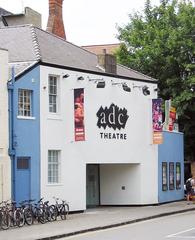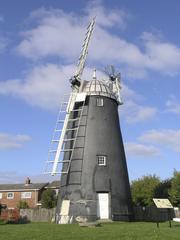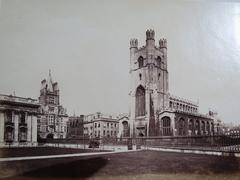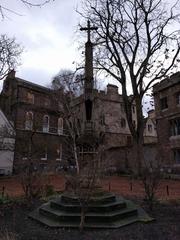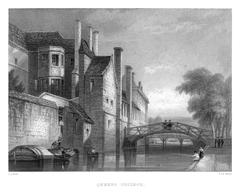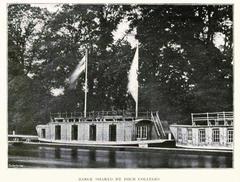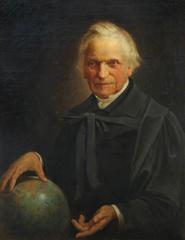Visiting Cambourne Nature Reserve: Hours, Tickets, and Nearby Attractions
Published Date: 01/08/2024
Introduction
Cambourne Nature Reserve, situated approximately 9 miles west of Cambridge, is a remarkable testament to how urban development can harmoniously coexist with natural conservation. Established in the 1990s, the reserve was part of the new parish of Cambourne, transformed from former farmland into a thriving natural habitat. This visionary urban planning effort prioritized the preservation and enhancement of natural environments, creating a ‘green infrastructure’ that supports a diverse array of wildlife (Wildlife Trust). Managed by the Wildlife Trust for Bedfordshire, Cambridgeshire, and Northamptonshire, the 95-hectare reserve offers a mosaic of habitats, including woodlands, lakes, ponds, grasslands, and an orchard, making it an ideal destination for nature enthusiasts and families alike. This comprehensive guide will delve into the reserve’s history, ecological significance, visitor information, and the community’s role in its conservation efforts, providing you with all the essential details for a memorable visit.
Table of Contents
- Introduction
- History and Significance
- Visitor Information
- Conservation Achievements
- Future Prospects
- FAQ
- Conclusion
History and Significance
Origins and Development
Cambourne Nature Reserve was established in the 1990s as part of the new parish of Cambourne, developed from former farmland. This transformation was guided by a visionary approach to urban planning that prioritized the preservation and enhancement of natural habitats (Wildlife Trust). The Wildlife Trust played a crucial role in establishing a ‘green infrastructure’ that retained existing natural features and developed new habitat networks to ensure wildlife could thrive alongside the growing human population (Cambs Open Space).
Ecological Significance
The Cambourne Nature Reserve spans 95 hectares and is interwoven throughout the town, creating a mosaic of habitats that support a diverse array of wildlife. Management practices include seasonal cutting of grass and hedges, maintaining paths and ditches, and continuous monitoring of wildlife populations (Wildlife Trust). The reserve supports rare and legally protected species, including great crested newts and water voles, and provides a habitat for numerous birds and butterflies (GPS Routes).
Community and Educational Impact
The reserve serves as an outdoor classroom where people of all ages can learn about nature and conservation. The Wildlife Trust organizes educational programs and events, fostering a connection between the community and the natural environment (Wildlife BCN). Volunteering opportunities in habitat management, wildlife monitoring, and educational outreach strengthen community bonds and foster a sense of stewardship for the local environment (Cambs Open Space).
Historical Landmarks and Features
The reserve includes historical landmarks like the community orchard with rare and local fruit trees and lakes created to manage excess water, which have become vital habitats for wetland birds. Early morning visitors might spot kingfishers, herons, or cormorants fishing in these waters (GPS Routes).
Visitor Information
Visiting Hours and Tickets
The Cambourne Nature Reserve is open to visitors year-round with no admission fee. Specific visiting hours may vary based on the season and specific events, so it is advisable to check the official website for the most up-to-date information.
Travel Tips and Accessibility
The reserve is accessible by car, with parking available at designated areas. Public transport options include buses from Cambridge. Paths within the reserve are well-maintained, accommodating visitors with different mobility needs.
Special Events and Guided Tours
Special events and guided tours are periodically organized by the Wildlife Trust. These events offer deeper insights into the reserve’s ecology and conservation efforts. Details about upcoming events can be found on the Wildlife BCN website.
Nearby Attractions
Visitors to Cambourne Nature Reserve can also explore nearby historical sites in Cambridge, such as the University of Cambridge colleges and the Fitzwilliam Museum, making it an ideal day-trip destination.
Conservation Achievements
Cambourne Nature Reserve stands as a model for successful urban conservation, showcasing the integration of natural habitats within urban areas. The thriving populations of various species, including great crested newts and water voles, highlight the effectiveness of thoughtful planning and community involvement in conservation efforts (Wildlife BCN).
Future Prospects
The continued success of Cambourne Nature Reserve will depend on sustained community engagement and support. The Wildlife Trust and local volunteers will play a crucial role in maintaining and enhancing the reserve’s habitats. Educational programs and community events will continue to foster a culture of conservation and environmental stewardship (Wildlife BCN).
FAQ
What are the visiting hours for Cambourne Nature Reserve?
The reserve is open year-round, but specific hours may vary. Check the official website for current information.
Is there an admission fee?
No, entry to Cambourne Nature Reserve is free of charge.
Are guided tours available?
Yes, guided tours are available and details can be found on the Wildlife BCN website.
How can I get involved?
Volunteering opportunities are available for habitat management, wildlife monitoring, and educational outreach. Visit the Cambs Open Space website for more details.
Conclusion
Cambourne Nature Reserve is a shining example of how urban development can coexist with and even enhance natural habitats. Its history, ecological significance, and community impact make it a valuable asset to the region and a model for future conservation efforts.
Call to Action
To stay updated on Cambourne Nature Reserve, follow us on social media and check our website for upcoming events and volunteering opportunities. Visit the reserve to experience the beauty and diversity of Cambourne firsthand!
